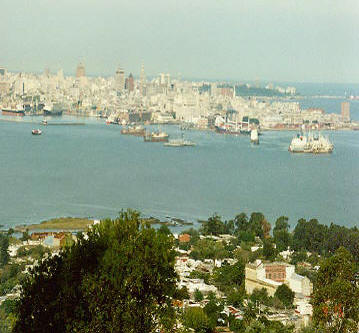|
||||||
|
Attractions
Montevideo
The capital and only large city sprawls along the banks of the Rio de la Plata, almost directly opposite Buenos Aires. It's a picturesque place of colonial Spanish, Italian and Art Deco styles. Most attention is focused on the Ciudad Viejo, the old city built on a peninsula close to the port and harbor, and the commercial center, located around Plaza Independencia to the east.
To get your bearings in the city center, take a walk from Plaza Independencia, the grandest of Montevideo's squares, through the Ciudad Vieja to the port. On the plaza is the black-marbled Mauseleo de Artigas, topped by an enormous statue of the national hero, and the 26-story Palacio Salvo, the tallest building in South America when built in 1927 and still the tallest in the city today. The Plaza Constitución, neoclassical Cabildo and the Iglesia Matriz, the oldest public building (1799) in the city, are further west. |
|
|
Other important sights in the area include the Museo Histórico Nacional, which consists of four different homes filled with historical effects, and the Museo del Gaucho y de la Moneda, which houses an impressive display of artefacts from Uruguay's gaucho (cowboy) past. Also, don't miss the Mercado del Puerto, once the finest port in South America, and now a colorful, lively center filled with markets, restaurants, artists and street musicians. The Feria de Tristán Narvaja is an outdoor market peddling groceries, antiques and souvenirs. A handful of sandy beaches stretch along the metropolitan waterfront and are popular excursions for the city's residents on summer weekends.
Inexpensive accommodation, eateries, nightclubs and theaters are found in the Ciudad Vieja, while the best shopping is along Avenida 18 de Julio, which runs eastwards from the old city.
The Uruguayan Littoral
West of Montevideo, and covering the portion of Uruguay which fronts the Río de la Plata and the Río Uruguay, is the country's most important agricultural area. Its outstanding attraction is the lively colonial city of Colonia (del Sacramento), an under-appreciated gem of narrow cobbled streets flanked by whitewashed buildings. The boating, fishing and swimming are good along the beaches of Mercedes, and there are many excellent museums in Paysandú, Uruguay's second largest city.
The Uruguayan Riviera
The area east of Montevideo is one of the most Westernized places in Uruguay with innumerable beach resorts, plenty of water activities and lots of well-groomed, narcissistic tourists sporting hibiscus shirts. Immediately east of the capital is the major resort of Atlántida, and Piriápolis is a mere flick of the towel away. From here, you can venture into the surrounding countryside and climb the 493m (1617ft) Cerro Pan de Azúcar or visit Minas, a lovely town set in wooded hills.
The largest and best known of the resorts is Punta del Este, one of South America's most glamourous and exclusive destinations. The place is awash with yacht and fishing clubs, golf courses, casinos and beautiful holiday homes. If that's not enough, there are excellent bathing beaches, perfect for swimming and sunbathing. Just offshore are Isla Gorriti, which has more superb beaches and the ruins of an 18th-century fortress, and Isla de Lobos, a nature reserve that is home to a large sea-lion colony. |
|

